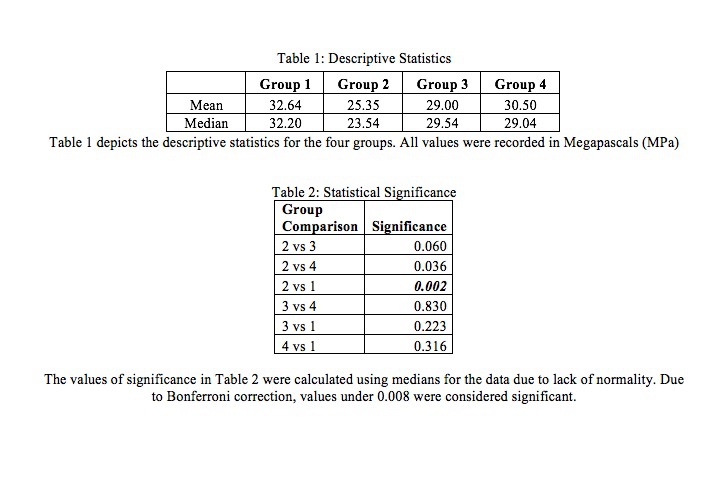IADR Abstract Archives
Optimal Bonding Properties of Assure PLUS® on Lithium Disilicate
Objectives: The purpose of this study was to assess which orthodontic adhesive, in combination with the orthodontic bonding resin Assure PLUS® (Reliance Orthodontic Products, Inc.), gives the maximum bond strength of brackets to lithium disilicate.
Methods: Lithium disilicate rods (IPS e.max® CAD) (Ivoclar Vivadent) 1x1x2 cm were created to represent porcelain crowns. The surfaces of the rods were sandblasted using 50 micron particle size alumina oxide, washed with water and air dried. One coat of Porcelain Conditioner (Reliance Orthodontic Products, Inc.), was applied with a brush and dried. Assure PLUS was then applied to the porcelain and lightly air dried, followed by one of four different adhesives. There were 72 samples (n=18): 1) Light BondTM (Reliance Orthodontic Products, Inc.), 2) Opal®BondTM (Ultradent), 3) Heliosit® Orthodontic (Ivoclar Vivadent), and 4) Transbond® XT (3M Unitek). After application of the adhesive a standard edgewise universal premolar bracket (American Orthodontics) was applied and light cured using a Radii Plus curing light (Southern Dental Industries) for twenty seconds. After 24 hours, the compressive bond strength was measured using a universal testing machine (Instron®5566A, Norwood, MA) with 1K load cell and 1mm/min cross-head speed.
Results: Group 1 (median=32.20 MPa) (Table 1) was found to have a statistically significant greater bond strength (P=0.002) when compared to group 2 (median=23.54 MPa). Due to lack of normality in the data, the Kruskal-Wallis test was done followed by post-hoc testing using Dunn’s test with Bonferroni Correction to determine significance (Table 2).
Conclusions: Within the framework of this study, group 1 had a significantly greater bond strength to e. max than group 2. There was no statistical difference between the other groups.
Methods: Lithium disilicate rods (IPS e.max® CAD) (Ivoclar Vivadent) 1x1x2 cm were created to represent porcelain crowns. The surfaces of the rods were sandblasted using 50 micron particle size alumina oxide, washed with water and air dried. One coat of Porcelain Conditioner (Reliance Orthodontic Products, Inc.), was applied with a brush and dried. Assure PLUS was then applied to the porcelain and lightly air dried, followed by one of four different adhesives. There were 72 samples (n=18): 1) Light BondTM (Reliance Orthodontic Products, Inc.), 2) Opal®BondTM (Ultradent), 3) Heliosit® Orthodontic (Ivoclar Vivadent), and 4) Transbond® XT (3M Unitek). After application of the adhesive a standard edgewise universal premolar bracket (American Orthodontics) was applied and light cured using a Radii Plus curing light (Southern Dental Industries) for twenty seconds. After 24 hours, the compressive bond strength was measured using a universal testing machine (Instron®5566A, Norwood, MA) with 1K load cell and 1mm/min cross-head speed.
Results: Group 1 (median=32.20 MPa) (Table 1) was found to have a statistically significant greater bond strength (P=0.002) when compared to group 2 (median=23.54 MPa). Due to lack of normality in the data, the Kruskal-Wallis test was done followed by post-hoc testing using Dunn’s test with Bonferroni Correction to determine significance (Table 2).
Conclusions: Within the framework of this study, group 1 had a significantly greater bond strength to e. max than group 2. There was no statistical difference between the other groups.

